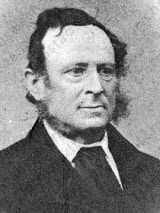Heinrich Küchler

Heinrich Georg Küchler (1811-1873) was a German ophthalmologist
Küchler was an innovator, and medical reformer whose early work on visual testing anticipated the later Snellen chart. Trained at Giessen and influenced by his studies in Paris, Küchler returned to Darmstadt in the 1830s to establish an eye practice and soon gained prominence for successful cataract surgery and original ideas in ophthalmic diagnostics.
In 1843, Küchler introduced one of the first systematic methods for assessing visual acuity: a chart composed of familiar symbols from household calendars, arranged in decreasing size, followed by a letter-based test in twelve graded lines. While lacking the precision and global adoption of the 1862 design of Herman Snellen, Küchler’s concept marked a decisive shift from arbitrary reading materials to standardized visual testing. His later surgical contributions included new techniques for corneal staphyloma repair, lid reconstruction, and refined cataract extraction, along with significant writings on ophthalmic surgery.
Beyond clinical practice, Küchler played a central role in medical infrastructure and military medicine. He co-founded the Mathilden-Landkrankenhaus, a charitable rural hospital, and organized field medical services during the wars of 1849, 1866, and 1870–71. His controversial advocacy of splenectomy and active engagement with surgical debates reflected his bold approach to medicine. A physician of technical skill and organizational vision, Küchler’s innovations in ophthalmology and healthcare organization secured him a place in the early history of modern eye care.
Biographical Timeline
- 1811 – Born April 23 in Darmstadt, Grand Duchy of Hesse.
- 1828–1833 – Studied medicine at University of Giessen; thesis on physiology of inflammation.
- 1834 – Returned to Darmstadt after Paris study visit; opened ophthalmic practice.
- 1835 – Published first paper (Heidelberg Medical Annals) on fatal arsenic poisoning.
- 1836–1839 – Arrested for political activism (Burschenschaft); imprisoned nearly 3 years.
- 1839 – Resumed practice; completed 23 cataract surgeries in one year.
- 1843 – Introduced symbol-based eye chart, followed by 12-line letter chart—a precursor to Snellen’s system.
- 1844 – Co-founded Mathilden-Landkrankenhaus, a rural charitable hospital.
- 1845–1853 – Developed surgical methods for corneal staphyloma; major paper in 1853.
- 1850 – Awarded Knight’s Cross of the Order of Philip the Magnanimous.
- 1855 – Reported third known human splenectomy, stirring controversy.
- 1862 – Appointed Obermedizinalrat (Chief Medical Advisor) in Hesse.
- 1863–1868 – Published on perineal suture, military medical organization (Sanitätsdienst im Grossherzogthum Hessen), and cataract extraction.
- 1868 – Promoted to Geheimer Obermedizinalrat (Privy Senior Medical Councillor).
- 1870–1871 – Directed field hospitals in the Franco-Prussian War; honored with Saxon War Service Cross.
- 1873 – Died March 29 in Darmstadt, aged 61
Early Visual Acuity Testing (1843–1844)
Küchler was the first to publish printed vision-test charts in 1843, introducing the Schriftnummerprobe für Gesichtsleidende (printed number and text samples for those with eye disease).

Optotypes with variable font sizes. Küchler, 1843
In 1844, he followed with a landmark paper, Ueber den Zweck und die beste Einrichtung von Gesichtsproben (On the Purpose and Best Arrangement of Sight Tests) in Medicinische Annalen (Vol. 10: 408–418), where he set out systematic principles for visual testing nearly 20 years before Herman Snellen.
Practical Instructions from Küchler’s Manual
- Charts printed on white paper, smoothly mounted on cardboard.
- Begin with the poorer eye, test in daylight from the side.
- Note lens prescription, and record any deviations from standard light or patient health.
- Ensure systematic size progression—each object should differ as equally as possible from its neighbors.
Conceptual Insights
- “One must not confuse eyesight (visual acuity) with refractive power.”
- Advocated for use of optotypes in diagnosing diseases like choroiditis—decades before the ophthalmoscope existed.
- Called for international standardization: “One would wish that doctors of big nations, and if possible, the whole world would agree on a single test object.”
Essential Conditions for an Ideal Test Object
- Universal comprehension (independent of literacy).
- Differ only by size and visual angle, not by shape or ornamentation.
- Ease of reproduction for consistency across clinics.
These principles foreshadowed Snellen’s approach almost two decades later—making Küchler a true pioneer in standardized vision assessment.
Key Medical Contributions
Ophthalmic Surgery and Corneal Repair
By 1839, Küchler had performed 23 cataract extractions in a year. He pioneered operative strategies for staphyloma reduction, eyelid reconstruction, and early cataract extraction, publishing his major staphyloma technique in 1853..
Splenectomy Controversy (1855)
Küchler reported the third documented human splenectomy, inciting professional debate. Though often condemned as reckless, this case reflected mid-19th-century experimental surgery at its boldest.
Medical Organization and Military Service
Founder of Mathilden-Landkrankenhaus (1844); served as Chief Medical Advisor, reorganizing Hesse’s hospital system. Directed field hospitals during the 1849, 1866, and 1870–71 wars. Authored Sanitätsdienst im Grossherzogthum Hessen (1866), codifying military medical care.
Legacy in Ophthalmology
Küchler’s innovations in vision testing foreshadowed the Snellen chart. His career blended technical surgery, diagnostic foresight, and systemic reform, leaving a multifaceted legacy in ophthalmology and medical administration.
Major Publications
- Küchler H. Optische Zeichenprobe zum Bestimmen der Sehschärfe. Darmstadt: 1843.
- Küchler H. Schriftnummerprobe für Gesichtsleidende. Darmstadt: Diehl; 1843
- Küchler H. Ueber den Zweck und die beste Einrichtung von Gesichtsproben. Medicinische Annalen 1844; 10: 408-418.
- Küchler H. Die Doppelnath zur Damm-Scham-Scheidennath und zu den Höhlennathen überhaupt 1863.
- Küchler H. Sanitätsdienst im Grossherzogthum Hessen. Darmstadt: 1866.
- Küchler H. Über die Extraction der grauen Stare beim Erwachsenen. Darmstadt: 1868.
References
Biography
- Dr. med. Heinrich Georg Küchler. Hessische Biografie
Eponymous terms
- de Jong PTVM. A history of visual acuity testing and optotypes. Eye (Lond). 2024 Jan;38(1):13-24.
Eponym
the person behind the name
BA MA (Oxon) MBChB (Edin) FACEM FFSEM. Emergency physician, Sir Charles Gairdner Hospital. Passion for rugby; medical history; medical education; and asynchronous learning #FOAMed evangelist. Co-founder and CTO of Life in the Fast lane | On Call: Principles and Protocol 4e| Eponyms | Books |
